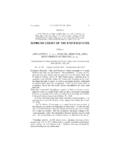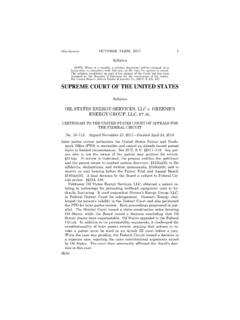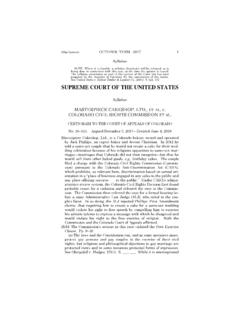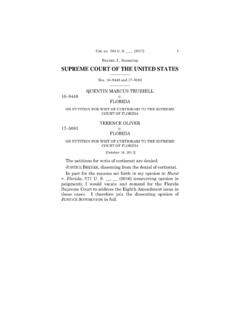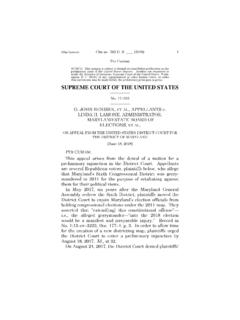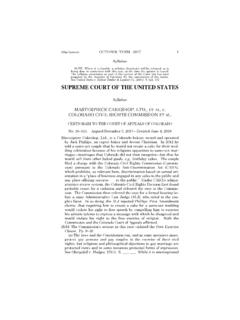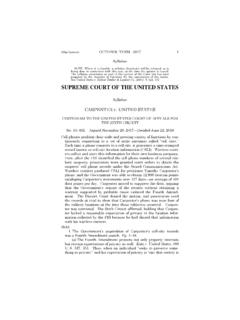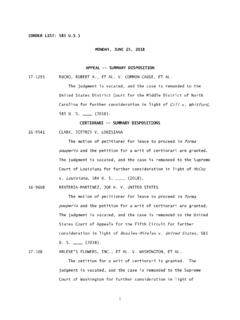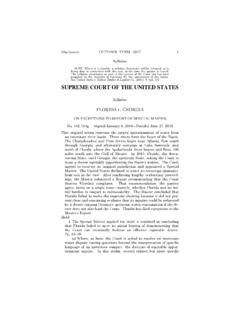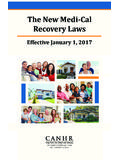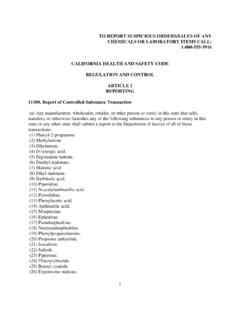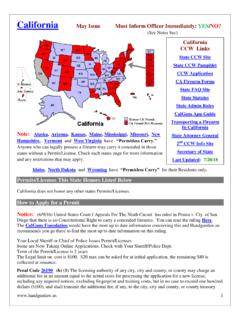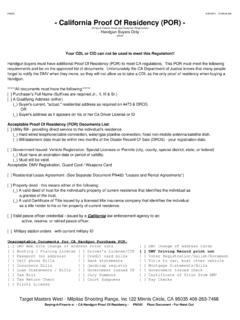Transcription of SUPREME COURT OF THE UNITED STATES
1 1 (Slip Opinion) OCTOBER TERM, 2017 Syllabus NOTE: Where it is feasible, a syllabus (headnote) will be released, as isbeing done in connection with this case, at the time the opinion is syllabus constitutes no part of the opinion of the COURT but has beenprepared by the Reporter of Decisions for the convenience of the reader. See UNITED STATES v. Detroit Timber & Lumber Co., 200 U. S. 321, 337. SUPREME COURT OF THE UNITED STATES Syllabus NATIONAL INSTITUTE OF FAMILY AND LIFE ADVOCATES, DBA NIFLA, ET AL. v. BECERRA, ATTORNEY GENERAL OF california , ET AL. CERTIORARI TO THE UNITED STATES COURT OF APPEALS FOR THE NINTH CIRCUIT No. 16 1140. Argued March 20, 2018 Decided June 26, 2018 The california Reproductive Freedom, Accountability, Comprehensive Care, and Transparency Act (FACT Act) was enacted to regulate cri-sis pregnancy centers pro-life centers that offer pregnancy-relatedservices.
2 The FACT Act requires clinics that primarily serve preg-nant women to provide certain notices. Clinics that are licensed must notify women that california provides free or low-cost services, including abortions, and give them a phone number to call. Its stated purpose is to make sure that state residents know their rights andwhat health care services are available to them. Unlicensed clinics must notify women that california has not licensed the clinics to pro-vide medical services. Its stated purpose is to ensure that pregnant women know when they are receiving health care from licensed pro-fessionals. Petitioners two crisis pregnancy centers, one licensedand one unlicensed, and an organization of crisis pregnancy centers filed suit. They alleged that both the licensed and the unlicensed no-tices abridge the freedom of speech protected by the First Amend-ment. The District COURT denied their motion for a preliminary in-junction, and the Ninth Circuit affirmed.
3 Holding that petitioners could not show a likelihood of success on the merits, the COURT con-cluded that the licensed notice survived a lower level of scrutiny ap-plicable to regulations of professional speech, and that the unli-censed notice satisfied any level of scrutiny. Held: 1. The licensed notice likely violates the First Amendment. Pp. 6 17. (a) Content-based laws target speech based on its communica- 2 NATIONAL INSTITUTE OF FAMILY AND LIFE ADVOCATES v. BECERRA Syllabus tive content and are presumptively unconstitutional and may bejustified only if the government proves that they are narrowly tai-lored to serve compelling state interests. Reed v. Town of Gilbert, 576 U. S. ___, ___. The licensed notice is a content-based compelling petitioners to speak a particular message, it alters thecontent of [their] speech.
4 Riley v. National Federation of Blind of N. C., Inc., 487 U. S. 781, 795. For example, one of the state-sponsored services that the licensed notice requires petitioners to ad-vertise is abortion the very practice that petitioners are devoted toopposing. Pp. 6 7.(b) Although the licensed notice is content-based, the Ninth Cir-cuit did not apply strict scrutiny because it concluded that the notice regulates professional speech. But this COURT has never recognized professional speech as a separate category of speech subject to dif-ferent rules. Speech is not unprotected merely because it is uttered by professionals. The COURT has afforded less protection for profes-sional speech in two circumstances where a law requires profes-sionals to disclose factual, noncontroversial information in their commercial speech, see, , Zauderer v. Office of Disciplinary Counsel of SUPREME COURT of Ohio, 471 U.
5 S. 626, 651, and where STATES regulate professional conduct that incidentally involvesspeech, see, , Ohralik v. Ohio State Bar Assn., 436 U. S. 447, 456. Neither line of precedents is implicated here. Pp. 7 14.(1) Unlike the rule in Zauderer, the licensed notice is not limited to purely factual and uncontroversial information about the terms un-der which .. services will be available, 471 U. S., at 651. Califor-nia s notice requires covered clinics to disclose information about state-sponsored services including abortion, hardly an uncontro-versial topic. Accordingly, Zauderer has no application here. P. 9. (2) Nor is the licensed notice a regulation of professional conductthat incidentally burdens speech. The COURT s precedents have longdrawn a line between speech and conduct. In Planned Parenthood of Southeastern Pa. v. Casey, 505 U. S. 833, for example, the joint opin-ion rejected a free-speech challenge to an informed-consent law re-quiring physicians to give a woman certain information as part of obtaining her consent to an abortion, id.
6 , at 884. But the licensed notice is neither an informed-consent requirement nor any other reg-ulation of professional conduct. It applies to all interactions between a covered facility and its clients, regardless of whether a medical pro-cedure is ever sought, offered, or performed. And many other facili-ties providing the exact same services, such as general practice clin-ics, are not subject to the requirement. Pp. 10 11. (3) Outside of these two contexts, the COURT s precedents have long protected the First Amendment rights of professionals. The COURT 3 Cite as: 585 U. S. ____ (2018) Syllabus has applied strict scrutiny to content-based laws regulating the non-commercial speech of lawyers, see Reed, supra, at ___, professionalfundraisers, see Riley, supra, at 798, and organizations providingspecialized advice on international law, see Holder v.
7 Humanitarian Law Project, 561 U. S. 1, 27 28. And it has stressed the danger of content-based regulations in the fields of medicine and publichealth, where information can save lives. Sorrell v. IMS Health Inc., 564 U. S. 552, 566. Such dangers are also present in the context of professional speech, where content-based regulation poses the same risk that the Government seeks not to advance a legitimate regula-tory goal, but to suppress unpopular ideas or information, Turner Broadcasting Systems, Inc. v. FCC, 512 U. S. 622, 641. When the government polices the content of professional speech, it can fail to preserve an uninhibited marketplace of ideas in which truth will ultimately prevail. McCullen v. Coakley, 573 U. S. ___, ___ ___. Professional speech is also a difficult category to define with preci-sion. See Brown v.
8 Entertainment Merchants Assn., 564 U. S. 786, 791. If STATES could choose the protection that speech receives simplyby requiring a license, they would have a powerful tool to impose in-vidious discrimination of disfavored subjects. Cincinnati v. Discov-ery Network, Inc., 507 U. S. 410, 423, n. 19. Pp. 11 14.(c) Although neither california nor the Ninth Circuit have ad-vanced a persuasive reason to apply different rules to professionalspeech, the COURT need not foreclose the possibility that some suchreason exists because the licensed notice cannot survive even inter-mediate scrutiny. Assuming that california s interest in providinglow-income women with information about state-sponsored service is substantial, the licensed notice is not sufficiently drawn to promoteit. The notice is wildly underinclusive, Entertainment Merchants Assn., supra, at 802, because it applies only to clinics that have a primary purpose of providing family planning or pregnancy-related services while excluding several other types of clinics that also servelow-income women and could educate them about the State s ser-vices.
9 california could also inform the women about its services without burdening a speaker with unwanted speech, Riley, supra, at 800, most obviously through a public-information campaign. Peti-tioners are thus likely to succeed on the merits of their challenge. Pp. 14 17. 2. The unlicensed notice unduly burdens protected speech. It is unnecessary to decide whether Zauderer s standard applies here, for even under Zauderer, a disclosure requirement cannot be unjustified or unduly burdensome. 471 U. S., at 651. Disclosures must remedya harm that is potentially real not purely hypothetical, Ibanez v. Florida Dept. of Business and Professional Regulation, Bd. of Ac- 4 NATIONAL INSTITUTE OF FAMILY AND LIFE ADVOCATES v. BECERRA Syllabus countancy, 512 U.
10 S. 136, 146, and can extend no broader than rea-sonably necessary, In re R. M. J., 455 U. S. 191, 203. california has not demonstrated any justification for the unlicensed notice that ismore than purely hypothetical. The only justification put forward by the state legislature was ensuring that pregnant women know when they are receiving medical care from licensed professionals, but california denied that the justification for the law was that womendid not know what kind of facility they are entering when they go to acrisis pregnancy center. Even if the State had presented a nonhypo-thetical justification, the FACT Act unduly burdens protected speech. It imposes a government-scripted, speaker-based disclosure require-ment that is wholly disconnected from the State s informational in-terest. It requires covered facilities to post california s precise notice,no matter what the facilities say on site or in their advertisements.
